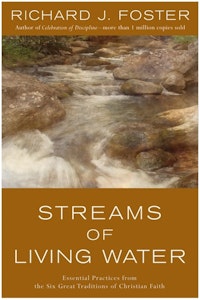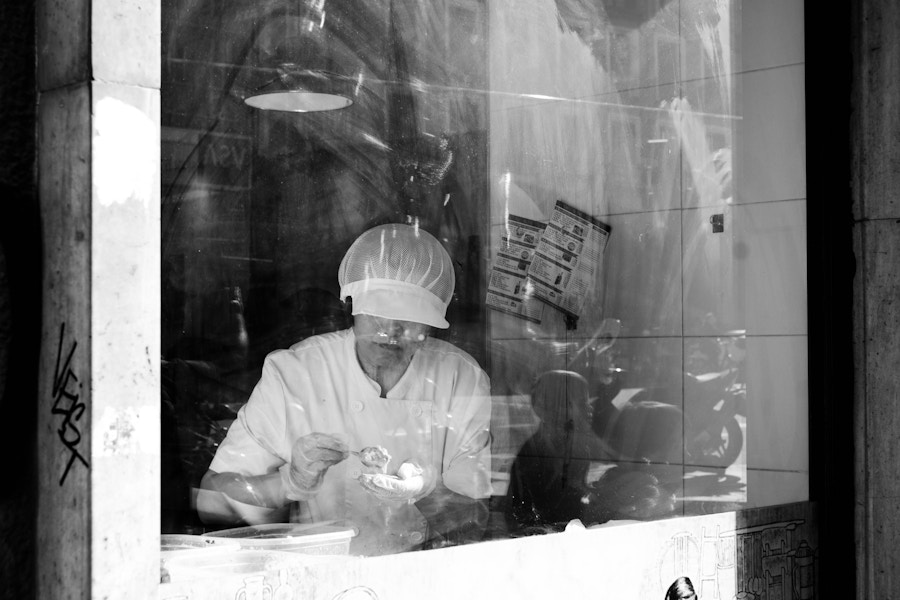 Excerpt from Streams of Living Water
Excerpt from Streams of Living Water
The Incarnational Tradition concerns itself with the relationship between spirit and matter. In short, God is manifest to us through material means.
Now, the spiritual and the material are not in opposition to one another, but are complementary. Far from being evil, the physical is meant to be inhabited by the spiritual. We are created so as to receive life from God, who is Spirit, and to express that life through our bodies and in the physical world in which we live. The material world is created, in part, so as to make visible and manifest the realm of the invisible spirit.
God loves matter. In his original creative acts God affirmed matter again and again, declaring it good at every point along the way. We, therefore, should take the material world quite seriously; it is the “icon” of God, the epiphany of his glory. We must not dismiss material things as inconsequential — or worse yet, as genuinely evil. The stuff of the material world what Pierre Teilhard de Chardin called “holy matter” — has been created by God and again he declared it to be good, very good (Gen. 1:25, 31). The material world is intended to enhance human life.1
It is also the realm or the place where we are to develop our spirit under God. One of the main functions of matter is to mediate the presence of an infinite God to finite minds. The Ark of the Covenant and the Tabernacle were divinely appointed arrangements so that God could be with human beings without destroying them. The same is true of the coming of the Messiah as a babe in a manger. These material realities are all graciously designed to allow for the necessary space between us and God. In this way God can come to us and we, in turn, can come to God. Divine realities are thus mediated to us through the finite realities of our personal histories, our social experiences, our physical bodies.
Now, there are fundamentally two arenas or dimensions of incarnational life. The first is what we, from a human point of view, would identify as the specifically religious dimension. The second is the arena of everyday life.
The Religious Dimension
The specifically religious dimension is most fully expressed in our corporate worship. Here we utilize the physical and the material to express and manifest the spiritual.
In this dimension of our life together it is important to underscore that all of us are liturgical. That is to say, we all use material and human “forms” to express our worship of God. There simply are no nonliturgical churches. Monastics rising to recite the Night Office and Quakers waiting in silent assurance upon the Spirit, Catholics praying the rosary and revivalists singing hymns of devotion to the name of Jesus, Russian Orthodox ritualists bowing amid incense and icon and Salvation Army evangelists marching to drum and tambourine — all are engaged in liturgy. We have a choice of liturgy, but we do not have a choice of whether to use liturgy. As long as we are finite human beings, we must use liturgy; we must express ourselves through forms of worship.2
Liturgy—liturgia—simply means “the people’s work.” Our task in liturgy is to glorify God in the various aspects of our worship life. We are to let the reality of God shine through the human or physical forms. This is true whether we are singing hymns or burning candles, dancing in ecstatic praise or bowing in speechless adoration. It is useful here to draw upon the Apostle Paul’s imagery of “the treasure in earthen vessels” (2 Cor. 4). The treasure is “the glory of God in the face of Jesus Christ,” as Paul put it (v. 6). The earthen vessel is the human body, along with the various cultural forms we use to manifest the treasure. To apply Paul’s imagery to the issue at hand, the “earthen vessel” is, very simply, our form of worship. We must always remember that the form itself is not the treasure; we worship God, never the form.
Understanding this imagery helps us appreciate others who do not worship in our way. We can recognize the treasure they are showing forth even though they worship in a different earthen vessel from us. Many earthen vessels, one treasure; many forms, one God and Father of us all.
We can even learn to rejoice in the beautiful variety of worship forms among the people of God. Evelyn Underhill (along with many others) speaks of forms of worship as “sacramentals,” by which she means that they are “more than symbols and less than sacraments.”3 In other words, these physical and material forms are efficacious signs helping the worshiping soul apprehend spiritual reality. In the eighth century John of Damascus argued in exactly this manner for the icons of Eastern Orthodox faith as signs or reflections of the eternal and spiritual reality.
This discussion of forms refers, of course, to far more than the icons of Eastern Orthodoxy. Consider the music of J. S. Bach and Charles Wesley and Fanny Crosby. Consider the profound silence of Quaker worship — the silence is itself a form, a liturgy of worship. Consider the rich tapestry of Anglican worship. Consider the warm vibrancy of Pentecostal worship. Consider foot-washing in the Brethren services or the laying on of hands in Charismatic circles or the Love Feast in House churches. The list could go on and on. Our worship becomes a magnificent, all-encompassing aesthetic experience. We see, we smell, we touch, we taste, we hear. We absorb the faith by reliving the gospel and the passion in the liturgy. In short, God is manifest to us through material means.
The Sacraments of the Church most completely demonstrate God’s use of matter to make present and visible the invisible realm of the spirit. They are, in fact, often called, “visible means of an invisible grace.” Sacraments are concrete actions by which we are marked and fed in such a way that the reality of God becomes embedded in our body, our mind, our spirit. The Holy Spirit grafts us into the Trinitarian life by burying and then raising us up in baptism. And the Holy Spirit continually feeds us by enacting the death and resurrection of Christ in the Communion service, or Eucharist.4
The Arena of Everyday Life
But the religious dimension is the beginning, not the end. We are to take this life and incorporate it into all we are and all we do. We bring it into daily life: into our homes, into our work, into our relationships with children and spouse and friends and neighbors and, yes, even enemies. Here we come to the most fundamental arena for the Incarnational Tradition: the arena of everyday life. It is the place, par excellence, in which we make visible and manifest the invisible realm of the spirit. To move into this sacramental way of living, we must take deep into our heart and mind Paul’s words, “And whatever you do, in word or deed, do everything in the name of the Lord Jesus, giving thanks to God the Father through him” (Col. 3:17).
The most basic place of our sacramental living is in our marriages and homes and families. Here we live together in well-reasoned love for everyone around us. Here we experience “the sacrament of the present moment,” to use the phrase of Jean Pierre de Caussade. We miss the point of this way of life if we are off conducting prayer meetings and other churchly enterprises when the duty of the present moment is to be home, playing with our children or caring for other domestic responsibilities. C. S. Lewis wisely observed, “The great thing, if one can, is to stop regarding all the unpleasant things as interruptions of one’s ‘own’ or ‘real’ life. The truth is of course that what one calls the interruptions are precisely one’s real life— the life God is sending one day by day: what one calls one’s ‘real life’ is a phantom of one’s own imagination.”5
Work is another everyday place — perhaps the most substantive place — for incarnational living. By “work” I am referring not merely to our job; I am referring to what we do to produce good in our world. I am referring to our vocatio, our vocation or calling.
Now, I really must bear down on this point of our work as the place for living sacramentally. While some have a special calling to pastoral or priestly work in order to equip the people of God, the calling or vocation for most of us is smack in the midst of the workaday world. And even here we often miss the point of a sacramental life. One business leader piously announced, “I instruct my secretary to set aside one noon hour a week when, instead of going out to some power lunch, I close the door on the dog-eat-dog world of business, open my Bible, and spend time alone with my Lord.” Now, this may well be a wise practice, but it is not yet sacramental living. The real issue is how we live and act and react in the midst of the dog-eat-dog world of power lunches and business dealings and board meetings. Or the dog-eat-dog world of restaurant managers and servers, of contractors and subcontractors, of middle management and office staff. Or the dog-eat-dog world of law and education and entrepreneurship. This is where people desperately need to see the reality of God made visible and manifest.
And this is where we learn to do our work as Jesus would do our work if he were in our place. Now, in understanding how this works, we need to underscore Jesus among us in his office as resurrected and exalted Lord, free from all the localizations of time and space, geography and history, gender and race, nationality and vocation. For he is in our place. He continually moves among us as our ever-present Teacher. He is, you see, the Lord of all vocations, and he really can teach us how to fulfill our calling. If you are a dentist, Jesus can teach you to do dentistry as he would do it if he were you. The same is true if you are a court stenographer, a computer programmer, a research scientist, a janitor, or the CEO of a multinational corporation. It is just as true if the thing you do to produce good in the world is raise a family or paint pictures or create stained-glass windows or peel potatoes. Whoever, whatever, wherever — he will teach you. Learn from him.
The third place — in addition to home and work — that we learn to live sacramentally is in society at large. Here we are to bring the reality of God to bear upon cultural, political, and institutional life. The theologians call this “the cultural mandate,” a teaching that is deeply rooted in the creation narrative, where God gives the human pair stewardship authority to care for and manage the earth (Gen. 1 – 3). And so we do. We work to lift our culture, not just through the commonsense moral standards of decency and honesty, but through art and literature and drama, justice and beauty and shalom. We nurture “the good, the true, the beautiful” throughout society — through the person-centered caring of the schools we run, through the beauty of the parks we build, through the entrepreneurial empowerment we offer the poor, through the imaginative and redeeming literature we write, through the ecological sensitivity we bring to land use and development, and so much more.
Family, work, society — these comprise the arena of everyday life. Now, it is of utmost importance that we keep a constant and intimate link between the specifically religious dimension and the arena of everyday life. This connection, incidentally, is seen in many of the “sacramental” passages in our New Testament— passages that carry this double reference to both the religious dimension and everyday life. In the sixth chapter of John, for example, where Jesus gives an extended teaching on “eating the flesh of the Son of Man and drinking his blood,” we immediately see both the reference to Communion and the call to our continual feeding on his life. As Jesus says, “The words that I have spoken to you are spirit and life” (John 6:63b). The same thing can be seen in Jesus’ discourse on “living water” with the woman at the well, where baptism stands in the background of his teaching on the sustaining life that he gives to all who trust in him.6
Martin Luther profoundly linked the religious sphere with common life when, in writing about baptism, he said, “For as long as we live we are continually doing that which baptism signifies, that is, we die and rise again. … [T]hat which baptism signifies should swallow up your whole life, body and soul, and give it forth again at the last day, clad in the robe of glory and immortality. We are therefore never without the sign of baptism nor without the thing it signifies.”7
This bridge is also seen in the Reformation principle of “the priesthood of all believers.” To be sure, this principle teaches us that “the plow boy and the milk maid” can do priestly work. But even more profoundly it teaches us that the plow boy in his plowing and the milk maid in her milking are in fact doing priestly work.
Have I given enough substance for you to grasp the concept of the Incarnational Tradition? I could say more, but my guess is that you have the sanctified imagination to take the central insight of this sacramental way of living and contextualize it into the many situations you face day in and day out.
Related Podcast
Excerpted from Streams of Living Water by Richard J. Foster, published by HarperOne. Copyright Richard J. Foster. Used with permission.
[1] Today we encounter the material world in its fallen state. It is “a good world gone bad,” as C. S. Lewis put it. Therefore, on a practical level, we are constantly dealing with the many distortions of the material universe the ways it can lead us into sin — and I will address some of these under the “perils” of the Tradition. But that constant pastoral and practical struggle must never keep us from affirming the goodness of matter as created by God.
[2] What is often called the liturgical movement began almost simultaneously in different parts of the Christian world in the years following the First World War. It has had different forms and colorings in each of the Christian confessions, and within these confessions it has developed in a variety of ways in various countries. While it is true that this movement has been most prominent among the “high churches,” hardly a group has been left untouched by it. And the liturgical flow moves both ways: many of the spontaneous liturgies of the “low churches” have been adapted into more sacramental settings with great benefit.
[3] Evelyn Underhill, Worship (Guildford, Surrey, UK: Eagle, 1991), p. 33.
[4] Throughout history different Christian groups have had various lists of official Sacraments. By the twelfth century the Roman Catholic Church had solidified its number at seven: baptism, confirmation, Eucharist, penance, extreme unction, holy orders, and matrimony. Sacraments in the Orthodox Church are officially called “holy mysteries,” and they usually list a similar seven. The idea of counting, however, may be misleading, for the more ancient practice of the Orthodox Church has been to consider everything that is in and of the Orthodox Church as sacramental or mystical. Protestants have tended toward two Sacraments baptism and Eucharist though they have often also stressed the sacramental quality of preaching. Quakers and the Salvation Army are the two groups that have done away completely with outward and visible Sacraments. Even these groups, however, stress the sacramental character of life and the need for a visible enfleshment of that life. This notion is well expressed in the following hymn written by Albert Orsborn, a general in the Salvation Army:
My life must be Christ’s broken bread,
My love his outpoured wine,
A cup o’erfilled,
a table spread Beneath his name and sign.
That other souls, refreshed and fed,
May share his life through mine.
[5] C. S. Lewis, They Stand Together: The letters of C . S. Lewis to Arthur Greeves (1914−1963), ed. Walter Hooper (New York: Macmillan, 1979), p. 499.
[6] See John 4:1 – 26. For an extended exegesis of this “double meaning” see Oscar Cullmann, Early Christian Worship (Philadelphia: Westminster, 1953).
[7] “Babylonian Captivity,” Luther’s Works, trans. A.T.W. Steinhauser, Frederick C. Ahrens, and Abdel Ross Wentz (Philadelphia: Muhlenberg, 1959), XXXVI, 57, as cited in James F. White, A Brief History of Christian Worship (Nashville, TN: Abingdon, 1993), p. 114.
Photo by Jose Antonio Gallego Vázquez on Unsplash
Text First Published October 1998 · Last Featured on Renovare.org November 2021


